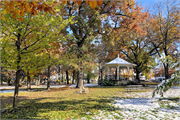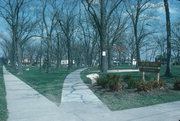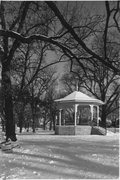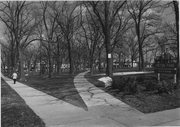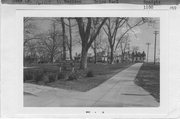Property Record
1100 SPAIGHT ST
Architecture and History Inventory
| Historic Name: | Village of Madison Cemetery |
|---|---|
| Other Name: | Orton Park |
| Contributing: | |
| Reference Number: | 16104 |
| Location (Address): | 1100 SPAIGHT ST |
|---|---|
| County: | Dane |
| City: | Madison |
| Township/Village: | |
| Unincorporated Community: | |
| Town: | |
| Range: | |
| Direction: | |
| Section: | |
| Quarter Section: | |
| Quarter/Quarter Section: |
| Year Built: | 1846 |
|---|---|
| Additions: | 1887 |
| Survey Date: | 19762019 |
| Historic Use: | |
| Architectural Style: | NA (unknown or not a building) |
| Structural System: | |
| Wall Material: | Unknown |
| Architect: | |
| Other Buildings On Site: | |
| Demolished?: | No |
| Demolished Date: |
| National/State Register Listing Name: | Orton Park |
|---|---|
| National Register Listing Date: | 12/18/1978 |
| State Register Listing Date: | 1/1/1989 |
| National Register Multiple Property Name: | |
| National/State Register Listing Name: | Orton Park Historic District |
| National Register Listing Date: | 10/31/1988 |
| State Register Listing Date: | 1/1/1989 |
| National Register Multiple Property Name: |
| Additional Information: | A 'site file' exists for this property. It contains additional information such as correspondence, newspaper clippings, or historical information. It is a public record and may be viewed in person at the Wisconsin Historical Society, Division of Historic Preservation-Public History. Originally a cemetery, Orton Park still contains some native oak and hickory and was Madison's first public park. Madison Landmark: 10/6/1975. City Beautiful. This park is also a contributing element of the Orton Park Historic District (listed 10/31/88). The bandstand is not contributing. City of Madison, Wisconsin Underrepresented Communities Historic Resource Survey Report: In 1887, Orton Park became Madison’s first public park. A century later, it played a role in the visibility of LGBTQ residents in the Williamson-Marquette neighborhood. The park is at the core of the neighborhood, which gained a reputation in the 1980s as a community that embraced the Gay Liberation Movement and had a relatively high concentration of LGBTQ residents. This reputation was cemented by the neighborhood’s stewardship of a casting of George Segal’s sculpture Gay Liberation from 1986 to 1990. The sculpture portrayed two couples of the same sex casually enjoying the park. The piece was commissioned to commemorate the 1969 Stonewall uprising in New York. Two castings were made; one was to be placed in a park across the street from the historic event and the other was to be installed at Stanford University in California. However, when it came time to install the work, the famously tolerant New York City neighborhood of Greenwich Village would not accept it. Some village residents opposed the installation, and local officials failed to allocate funding for it. The Williamson-Marquette neighborhood agreed to host the sculpture, and, with the support of the city, it was installed in Orton Park until installation at its intended location became feasible. The LGBTQ community saw the sculpture as a tangible public symbol of their presence at a time when the community was trying to cultivate positive visibility. |
|---|---|
| Bibliographic References: |
| Wisconsin Architecture and History Inventory, State Historic Preservation Office, Wisconsin Historical Society, Madison, Wisconsin |

